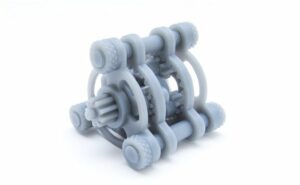Thanks to technological advancements, the rapid prototyping industry has seen stunning amounts of growth over the last ten years. This booming market is worth millions of dollars and is responsible for a major revolution in the way that associated manufacturers design and create new parts.
Quick Insights
The rapid prototyping market accounts for material suppliers, manufacturers and distributors, and the engineers and designers who rely on these products. Rapid prototyping technologies include 3D printing, CNC machining, and other on-demand manufacturing methods.
- The rapid prototyping market has had an average yearly growth of 27% since 2015.
- The 2020 value of the U.S. rapid prototyping market is estimated at $309.9 million.
- The global rapid prototyping market is expected to be worth $2.6 billion by 2025.
- The thermoplastic market segment is the most popular, with both SLS and SLA rapid prototyping seeing regular orders from all sectors.
- The industries most likely to make use of rapid prototyping services include healthcare, transportation, consumer goods, and manufacturing.
These statistics represent a major shift in the way that engineers design and test new products. From individual models to batches of as-needed parts, rapid prototyping has made quick and cost-effective manufacturing a reality for nearly every commercial field.
Growth Statistics
The rapid prototyping industry has seen rapid growth for the last decade. Between 2010 and 2015, the U.S. market grew by an average of 22% every year. From 2015 to 2020, this yearly growth increased to an average of 27%. In 2020, the current market value is estimated at around $309.9 million.
Although the United States has the greatest market share, rapid prototyping has also seen worldwide popularity. If current growth rates continue, the global rapid prototyping market is expected to be worth 2.6 billion by 2025. This statistic includes a compound growth rate of 41% in the Asia-Pacific market, where massive industrialization has increased the demand for both manufacturing goods and consumer products.
Market Segments
Nearly every manufacturing industry has benefited from rapid prototyping technology. However, a few specific market segments have come to rely on rapid manufacturing as a regular part of their design and production process.
Healthcare: The healthcare industry continues to dominate the rapid prototyping market. 3D printing services are commonly used to create surgical models, medical devices, and custom implants.
Manufacturing and Construction: The ability to design custom parts on an as-needed basis has been a great boon to engineers in all industries. Rapid prototyping can be used to create unique parts that fit perfectly and which can be ordered in small batches with quick delivery times.
Consumer Goods and Electronics: From toys to tools to cases, the rapid prototyping industry has become one of the primary sources of consumer-ready plastic parts. This manufacturing method allows companies to achieve identical products across multiple print runs and has drastically reduced the cost of wholesale production.
Transportation: The advantages of rapid prototyping have not been lost on the automotive industry. In addition to testing new designs, many engineers use 3D printing to create highly detailed parts that would not be viable with traditional manufacturing methods.
Aerospace and Defense: The aerospace and defense industries have greatly benefited from the unique properties of 3D printing and other on-demand manufacturing methods. In particular, the focus on durable yet flexible materials has resulted in the creation of innovative designs that are suited for a variety of extreme applications.
Read more: A review of the rapid prototyping industry

